Exploring the Thrills of Freestyle Mountain Biking


Intro
Freestyle mountain biking, often referred to simply as freestyle biking, is more than just a sport; it's a way of life for many. This adrenaline-infused discipline stands apart from traditional mountain biking, focusing on skill, creativity, and sometimes sheer audacity. It's not just about riding from point A to point B; rather, it involves tricks, jumps, and stunts that challenge not only the limits of the bike but also the skills of the rider.
What sets this sub-discipline apart is its rich history and the passionate community that surrounds it. The roots of freestyle biking can be traced back to the early days of BMX, evolving rapidly as enthusiasts began to adapt their techniques for use in the rugged terrains of mountain environments. This evolution reflects a broader pattern within extreme sports, where innovation often stems from the desire to push boundaries.
In the pages that follow, we'll explore the various facets of freestyle mountain biking — from its definition and history to essential gear and training tips. Equip yourself with insights into the exhilarating world where daring meets skill, making this sport a thrilling avenue for those seeking both challenge and community.
Preamble to Freestyle Mountain Biking
Freestyle mountain biking stands at the crossroads of adventure and artistry, creating a unique blend that attracts thrill-seekers and skillful riders alike. This introduction serves to map out the foundational elements of this exhilarating sport, highlighting its significance in the broader spectrum of mountain biking. Understanding freestyle mountain biking goes beyond mere participation; it embodies a lifestyle, a community, and a rich history brimming with innovation and expression.
Definition and Overview
Simply put, freestyle mountain biking is a creative approach to mountain biking that emphasizes tricks, jumps, and maneuvers. Unlike traditional mountain biking, which focuses more on the endurance of trails and rough terrain, freestyle biking showcases the rider's technical prowess and style. This sport often takes place in customized environments, such as dirt parks, urban settings, and ramps designed specifically for stunts.
In freestyle mountain biking, the essence lies within the rider's ability to manipulate their bike not merely for speed but for expression. Riders often perform stunts like tricks, flips, and spins—each showcasing a combination of skill and flair that captivates both participants and onlookers.
Historical Context
The roots of freestyle mountain biking trace back to the early 1970s, as riders began experimenting with the limits of what was possible on two wheels. The sport emerged organically out of a desire for self-expression and the thrill of defying gravity. One can clearly see its connection to BMX biking, where riders began pulling off aerial tricks in skate parks and streets, eventually bringing this idea to mountain terrains.
The 1980s saw the growth of informal competitions, laying the groundwork for organized events. Places like the famous Woodward Camp in Pennsylvania became hot spots for gathering talented riders who wanted to showcase their skills. Over the years, the sport has continued to evolve, adapted technologies and influences. As it grew in popularity, major competitions like the X Games put freestyle mountain biking on the global stage.
From its early roots in BMX to its flourishing presence today, freestyle mountain biking reflects not just a sport but a cultural movement. The participants, driven by passion and creativity, continuously push the boundaries of what is achievable in the realm of biking.
"To ride freestyle is to dance with the ground and the air, crafting a connection that is both temporary and profound."
In summary, the exploration of freestyle mountain biking opens up a diverse avenue of artistic expression, athleticism, and community. As we further delve into techniques, styles, and equipment, it becomes clear that this sport is about more than just the bikes; it’s a lifestyle that resonates deeply with its enthusiasts.
Key Techniques and Skills
Freestyle mountain biking is as much about finesse as it is about raw power. The techniques and skills that make up this sport are essential for performance, fun, and safety. Understanding these elements gives riders the ability to push their limits while also being smart about risk management. This section will dive into the foundational skills as well as more advanced tricks, honing in on why they matter for both amateurs and seasoned enthusiasts alike.
Fundamental Riding Skills
Before jumping into flips and spins, a rider must master the basics. Riding skills include proper pedaling techniques, balance control, and general bike handling. These foundational skills create a solid basis for any rider to progress.
Some essential skills to focus on include:
- Brake control: This helps you gauge speed and deceleration while coming into jumps or obstacles.
- Body positioning: Proper posture can significantly affect balance, especially on uneven terrain.
- Cornering techniques: Learning how to corner effectively allows a rider to maintain speed while navigating tight turns.
By practicing these fundamental skills, cyclists will find themselves feeling more comfortable and confident on their bikes. It sets the stage for mastering the bigger tricks that come later.
Advanced Tricks and Maneuvers
Once a rider can confidently handle their bike, it's time to step into the exhilarating world of advanced tricks. These maneuvers not only add flair but can also improve overall agility on the bike. Let’s break down some major categories in this realm.
Jumps
Among the crown jewels of freestyle biking, jumps epitomize thrill-seeking. Riders launch themselves into the air, executing various mid-air tricks, showcasing skill and creativity. What makes jumps a popular choice is their ability to combine aerial performance with raw speed. A rider can be soaring into the sky, and that feeling of weightlessness is incomparable.
However, jumps come with significant risks. If not properly executed, they could lead to falls and injuries. Hence, bike setup, including suspension and tire pressure, must be adapted for jumps. Another consideration is landing technique, which can determine a rider's safety.
Slides
Slides offer a different type of excitement compared to jumps. By shifting the bike sideways while maintaining momentum, riders can corner significantly sharper or execute impressive tricks. The key characteristic of slides is control; riders must manage their balance to prevent a wipeout.
The graceful flow of a slide allows for impeccable style points in competitions. Still, it demands practice; a poorly executed slide can easily turn disastrous. The call for accurate weight distribution cannot be underestimated.
Flips
Flips will definitely raise the adrenaline level. This trick involves rotating the bike head over tail. Many riders find flipping to be a personal holy grail as it combines technical skill with a sense of daring. The complexity of flips lies in the timing; too early or too late can lead to significant consequences.
Riders looking to flip should practice precisely how to initiate the spin and gauge the bar height for a clean landing. Undoubtedly, mastering this trick requires patience and practice but adds an impressive element to any rider's repertoire.
Spins
Spins entail rotating the bike around its vertical axis, adding flair and complexity. This is more than just a pretty move; spins test a rider's center of gravity management. Riders can perform 360s or even 720s, depending on skill and bravery, making spins a crowd favorite in competitions.
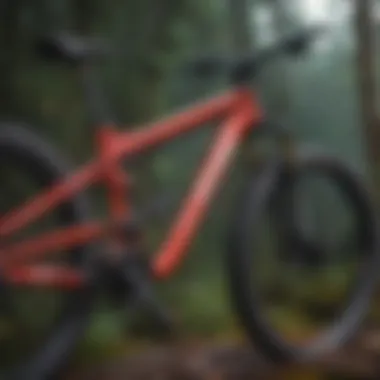
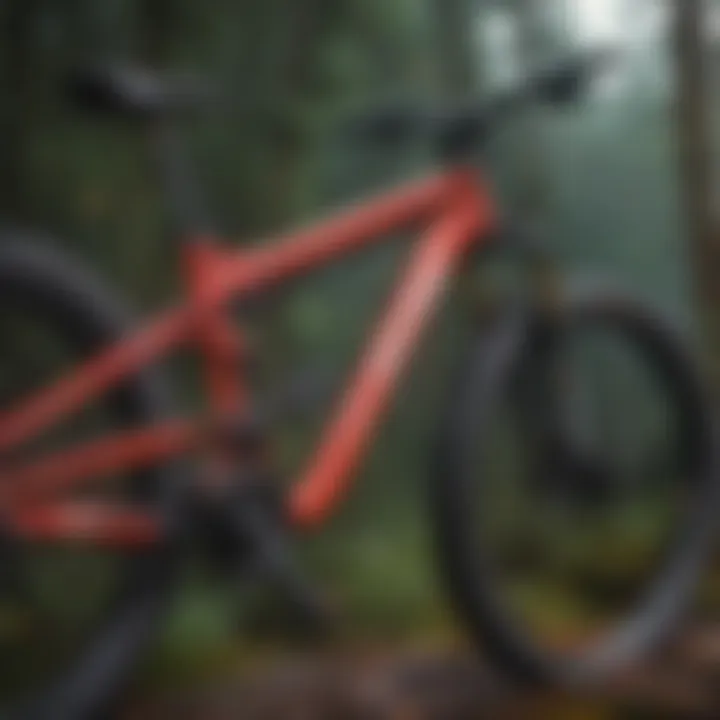
The critical aspect of spins is spotting the landing while performing the rotation. It will make all the difference in a clean trick versus a reminded, tumbler-like crash.
Safety Techniques
With all these thrilling techniques comes the necessity of safety. A focus on safety will help riders enjoy their time on the trails without worries of avoidable injuries. Riders should consistently wear protective gear such as helmets, knee pads, and gloves. Always inspect equipment before riding and know the limits of both the bike and one’s abilities.
It's pivotal for riders to practice techniques gradually, respecting the learning curve. Progressing too quickly could lead to dangerous situations.
Ultimately, skills in freestyle mountain biking allow for expression and exploration of personal limits, but they must be balanced with measures for safety.
The Equipment of Freestyle Mountain Biking
When it comes to freestyle mountain biking, the equipment is the backbone of both performance and safety. Riders need to understand what makes a good bike and the importance of protective gear. Every component contributes to the rider's skill, comfort, and overall experience. It’s not just about having the coolest bike or the flashiest gear; it’s about finding the right fit for your unique style and ensuring safety while pushing limits.
Bicycles and Models
A crucial aspect of this sport is, undoubtedly, the bikes themselves. Not all mountain bikes are created equal, particularly when looking at the freestyle variation. Freestyle mountain bikes come equipped with durable frames, often designed to handle rigorous impacts and landings.
- Popular Models: Some of the models that stand out include the Specialized P.3, known for its lightweight frame making it a favorite among dirt jumpers, and the Trek Ticket S, which offers exceptional performance for slopestyle riders.
- Key Characteristics: The geometry of these bikes is vital, with features typically including a short chainstay for better maneuverability and a higher bottom bracket to prevent pedal strikes on landings.
Ultimately, selecting the right bike often comes down to personal preference and riding style. Riders who prefer the adrenaline of street tricks may favor lighter bikes with specific geometries tailored for agility, whereas those leaning toward slopestyle require robust bikes that withstand higher jumps and rougher terrains.
Protective Gear
Helmets
In freestyle mountain biking, a good helmet isn’t just a recommendation; it’s a necessity. A well-fitted helmet protects the brain during falls, which can be all too common in this high-octane sport. The helmet orbits the rider’s head, cradling it firmly, while providing adequate ventilation, enabling airflow even during intense rides.
- Key Characteristic: Full-face helmets are favored when performing tricks as they provide extra protection for the face. Their design often includes a chin guard, which can save a rider during a harsh tumble.
- Unique Feature: Modern designs often incorporate lighter materials without sacrificing safety, making them a great option for those who prioritize comfort. However, these helmets may come with a higher price tag.
Pads
Protective pads are another cornerstone in safety. From knee pads to elbow pads, they serve as a shield between the rider and the unforgiving ground. The flexibility of the pads allows for freedom of movement while offering some peace of mind.
- Key Characteristic: Look for pads that are lightweight yet provide substantial padding. They should fit snugly without constraining movement, allowing for performance without the added worry.
- Unique Feature: Many pads available today are designed with moisture-wicking materials, keeping riders comfortable as they sweat. Some specific models can be bulkier, providing added protection but sacrificing some mobility during tricks.
Footwear
Footwear may seem like a basic aspect of mountain biking, but it carries significant weight in both performance and safety. The right shoes enhance grip on the pedals, providing riders with better control.
- Key Characteristic: Many bikers opt for flat-soled shoes with good tread patterns that keep them stable on the pedals during jumps and tricks. Brands like Five Ten are popular for their exceptional grip.
- Unique Feature: Some footwear is even designed with reinforced areas to protect the feet from impacts. However, they can prove more rigid, potentially causing discomfort on long rides.
Maintenance and Care
The importance of maintenance cannot be overstated. Proper care ensures not just the longevity of the bike, but it also plays a direct role in rider safety. Regularly checking brake systems, tire pressure, and chains can prevent malfunctions while riding.
- Routine Checks: Make it a habit to inspect cables, gears, and the frame for any damage. Keeping an eye out for wear can save a ride from turning sour.
- Cleaning and Lubrication: Accumulated dirt can impact bike performance. Regular cleaning and lubricating moving parts improve functionality and longevity, leading to smoother rides and better performance.
Styles of Freestyle Mountain Biking
Freestyle mountain biking is a diverse sub-discipline that showcases a range of styles, each with unique techniques, environments, and challenges. Understanding these styles is crucial for riders as it opens up opportunities for creativity and personal expression on the bike. Not only do different styles offer specific experiences; they also foster community interaction, providing platforms for various events, competitions, and meet-ups. Whether a rider is hitting dirt jumps or navigating urban landscapes, each style contributes to the evolving culture of freestyle mountain biking.
Dirt Jumping
Dirt jumping is probably one of the most visually striking forms of freestyle biking. Riders exploit jumps built from mounds of earth, launching themselves high in the air to execute tricks and stunts. The ideal setup for dirt jumping includes a series of well-crafted jumps with a smooth landing. This style emphasizes both speed and technique, as a rider needs to time their jump perfectly to gain the requisite height and control.
This style isn’t just about the jumps themselves; it’s about the entire flow of the ride. Riders typically study the trajectory of their jumps, making mental notes of which body positions yield the best results. The thrill of defying gravity, even for just a few seconds, serves as an adrenaline rush that many seek out.
Street Riding
Street riding transforms urban landscapes into playgrounds, with bikers often using the architecture around them as obstacles to explore. This style takes advantage of stairs, rails, ledges, and other city elements to create new lines and tricks. Riders must have a sharp eye for possibilities that lie within their environment, turning the mundane into something extraordinary.
The culture of street riding celebrates ingenuity as much as skill. Many riders share videos showcasing creative lines, often pushing the boundaries of what can be done on a bike. It challenges not only the physical but also the mental aspect of riding, as navigating an urban environment requires quick thinking and adaptability. Moreover, this style often fosters local riding communities, where riders gather to explore and innovate together.
Park Riding
Park riding is popular among many enthusiasts, especially those who frequent dedicated bike parks. These parks are designed specifically for freestyle mountain biking and offer various features like ramps, rails, and bowls. Riders can practice systematically, working on completing specific tricks or honing their finesse on transitions.
In a park, every feature is typically crafted with precision, which allows riders to focus on technical aspects without the variable of natural terrain. There’s a unique camaraderie in bike parks; you often see groups encouraging each other as they attempt new tricks and perfect their form. What really sets this style apart is the blend of skill development with community engagement, as riders often share tips and celebrate each other's progress.
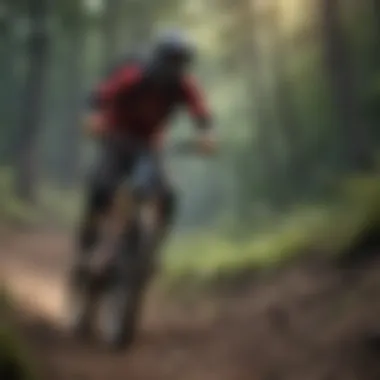

Slopestyle
Slopestyle combines elements of both dirt jumping and park riding. In slopestyle events, riders navigate courses that feature a mix of natural terrain and purpose-built obstacles. This style is about both style and technical performance, demanding creativity, speed, and an innate understanding of balance.
During competitions, riders frequently showcase their signature tricks, weaving through a series of jumps, drops, and technical features—all while maintaining flow and speed. It’s a high-stakes environment, pushing riders to perform at their absolute best, thus elevating the standard of the sport overall.
"Slopestyle is where creativity shines; it's not just about executing tricks, but about the style and flow in how you do them."
Each of these styles encapsulates a different facet of freestyle mountain biking, catering to various interests and skill sets. As the sport evolves, riders continue to define and redefine these styles, pushing the boundaries of what’s possible while building connections within their communities.
Global Competitions and Events
In the realm of freestyle mountain biking, competitions and events play a vital role in showcasing talent and pushing the boundaries of the sport. These events not only provide a stage for riders to display their skills but also foster a sense of community among enthusiasts and serve as a platform for innovation and progression in techniques and equipment. The excitement generated by competitions helps sustain the sport’s popularity and encourages new riders to join the fray.
Major Competitions
Games
The X Games stands tall as one of the premier events in the freestyle mountain biking calendar. This competition serves as a melting pot of extreme sports, where athletes from all corners of the globe gather to compete at the highest level. One defining characteristic of the X Games is its high-energy atmosphere, which features not only mountain biking but also skateboarding, BMX, and various other extreme sports.
The exposure and credibility offered by the X Games have catapulted many athletes into the limelight. Additionally, it often features innovative courses that challenge riders to push their limits, offering an array of challenges that test speed, agility, and creativity. The live audience, paired with global broadcasting, emphasizes the event's significance in promoting freestyle mountain biking.
"The X Games is the golden playground for adrenaline seekers, where every trick and spin is met with cheers and gasps from thousands of fans."
However, the competitive nature of the X Games can be daunting. The pressure to perform amid world-class athletes often leads to injuries as riders attempt high-risk tricks, making it a double-edged sword for many participants.
Red Bull Rampage
Red Bull Rampage is another cornerstone in the competition landscape for freestyle mountain bikers. What sets Rampage apart is its unique approach to course design, which focuses heavily on natural terrain, pushing riders to showcase their skills against a backdrop of stunning landscapes. The event has gained a reputation for its awe-inspiring visuals and the sheer audacity of the riders participating.
The key aspect of Red Bull Rampage is its emphasis on freedom and creativity during competition. Riders have the opportunity to showcase their individual styles by customizing their lines on the mountain, highlighting the essence of freestyle biking. This decision-making aspect can lead to extraordinary performances, often capturing breathtaking moments that resonate with fans.
Nevertheless, it's essential to note that the risks involved are significant. The natural terrain presents unpredictable hazards, meaning that safety must be a rider's top priority, often leading to severe injuries for those who miscalculate their jumps.
FMB World Tour
The FMB World Tour acts as a global circuit for freestyle mountain biking competitions, unifying a range of events from various locations. This series allows riders to accumulate points based on their performances, fostering a competitive spirit throughout the season. The FMB World Tour features a blend of urban and natural landscapes, making it versatile and inclusive for riders of all skill levels.
A defining feature of the FMB World Tour is its structured hierarchy, which progresses from lower-tier competitions to elite events. This provides avenues for up-and-coming riders to gain exposure and experience, ultimately allowing them to climb the ranks. Benefits of participating in the World Tour include networking with other riders, gaining sponsorship opportunities, and building credibility.
However, riders also face the challenges of traveling and competing on diverse courses, which can strain their finances and skill sets. The pressure to perform consistently across different formats is yet another hurdle that can be as rewarding as it is demanding.
Local Events and Community Gatherings
Alongside major competitions, local events and community gatherings play an equally substantial role in the freestyle mountain biking ecosystem. These grassroots initiatives attract riders of all levels, encouraging skill-sharing and fostering a sense of belonging. They are less formal than major competitions, often emphasizing fun, safety, and camaraderie over cutthroat competition.
Participating in local events helps enhance the community's support systems, where riders can exchange tips and build friendships. Community gatherings bring together families and friends, creating an inclusive atmosphere that extends beyond biking. Such events can also lead to the discovery of new talent, setting the stage for the next generation of professional riders.
In summary, both global competitions and local events are essential for the growth and sustainability of freestyle mountain biking. They inspire motivation, cultivate talent, and bind communities together, illustrating the importance of collaboration and shared experience in this thrilling sport.
The Role of Technology
In the vivid world of freestyle mountain biking, technology plays a crucial role that is often underestimated. The evolution of biking tech has not only reshaped the equipment used but has also influenced riding styles and safety measures. So, let’s take a moment to unpack how innovation has transformed this spirited sport.
Innovations in Biking Technology
The landscape of biking technology is constantly changing, with a slew of innovations emerging. Bicycles today are a far cry from the heavy, clunky models of yesteryear. Lightweight frames, made from materials like carbon fiber or advanced aluminum, have effectively reduced the overall weight, giving riders better control and agility. Modern suspension systems, for instance, offer increased responsiveness that lets bikers navigate rough terrains with ease—this increases the confidence of both budding amateurs and seasoned pros.
Another area where tech has made waves is in the wheels and tires sector. Advances in tire design have led to improved grip and shock absorption capacity, making it possible for riders to take on more rigorous trails without the fear of losing control.
Bringing it all together
Some notable innovations that have left their mark on freestyle mountain biking include:
- Disc brakes: Offering superior stopping power in comparison to traditional systems, disc brakes enable riders to slow down with precision, especially on steep descents.
- Boost spacing: This refers to the wider hub spacing that provides better wheel stiffness, enhancing stability during high-speed maneuvers.
- Smart technology: Some modern bikes even have integrated tech, such as fitness trackers and GPS, to help bikers monitor their performance and navigate trails efficiently.
"Technology is not just changing the bikes. It's enhancing the rider's experience, making it safer and more enjoyable."
Impact on Performance
The advancements in bike technology certainly lead to notable improvements in performance. For one, the lighter frame allows for greater acceleration and improved climbing capabilities. Riders can traverse hills without feeling the weight dragging them down. This is significant for tricks like dirt jumping or slopestyle, where every ounce counts when launching off a ramp.
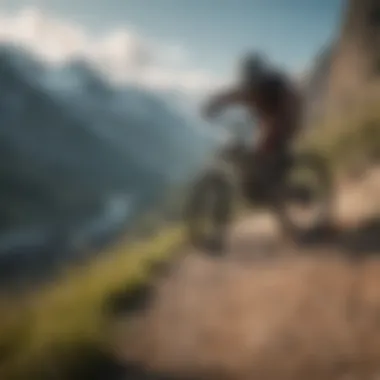
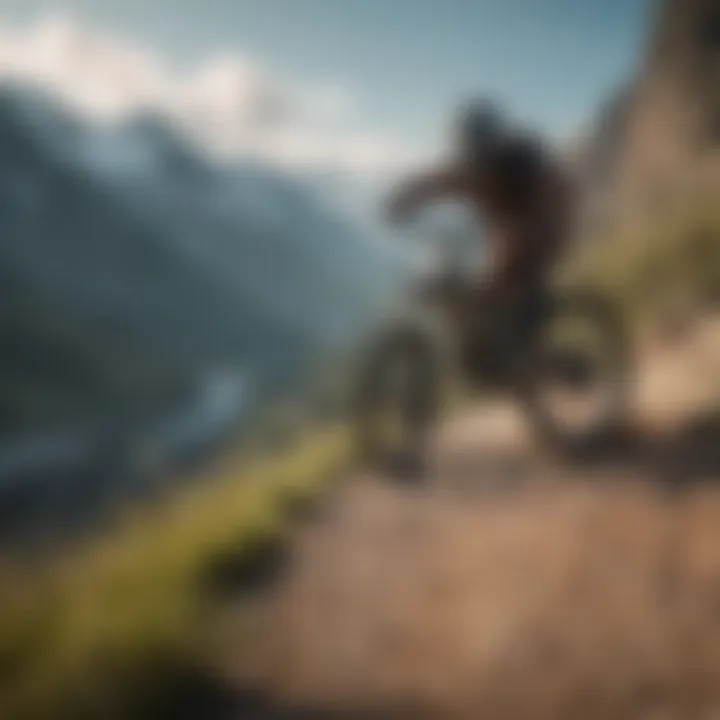
Furthermore, the evolution of suspension systems allows for a smoother ride—even over rocky terrain. Riders can focus on technique and the next big trick instead of worrying about comfort, which leads to an increase in confidence.
Effective gear can also lead to better energy transfer. For instance, well-engineered pedals ensure that all the force applied by the rider is efficiently converted into speed. When bikers are not limited by their equipment, they can push their own limits further, expanding their skill set and performing more complex maneuvers.
In summary, advancements in biking technology are playing an invaluable role in shaping the way freestyle mountain biking is practiced and enjoyed. Not only does it enhance performance for riders across all skill levels, it also cultivates a safer environment to explore new heights in both skill and community engagement.
Cultural Aspects of Freestyle Mountain Biking
Freestyle mountain biking is much more than just a sport—it’s a lifestyle steeped in culture and passion that brings together riders from diverse backgrounds. The community surrounding it thrives on shared experiences, adrenaline-filled moments, and a love for the outdoors. Understanding the cultural aspects of freestyle mountain biking is key for anyone looking to immerse themselves in this exciting realm. It broadens perspectives, establishes connections, and enriches the enjoyment of riding.
Community and Shared Passion
At the heart of freestyle mountain biking is a vibrant community that fosters a sense of belonging. Whether it’s gathering at a local bike park on the weekends or discussing techniques and tricks in online forums, this sport cultivates relationships built on mutual respect for skill levels and individual styles. Each rider brings something unique to the table, whether it’s a different approach to riding or a distinct flair for tricks.
Key components that enhance the community spirit include:
- Events and Competitions: Local jams and competitions, such as the Red Bull Rampage, create a stage for riders to showcase their talents. These events not only highlight skill but promote camaraderie among competitors and spectators alike.
- Online Platforms: Social media platforms like Reddit and Facebook can serve as hubs for sharing videos, tricks, and tips. These communities are treasure troves of insights, allowing riders to connect globally, thus breaking geographical barriers.
- Group Rides: Official or informal group rides become a ritual, where riders exchange wisdom, mentor beginners, and celebrate small victories together.
This sense of community boosts individual confidence, encouraging riders to push their limits and explore their riding potential in a supportive environment.
Influence on Lifestyle and Identity
Freestyle mountain biking goes beyond the trails; it seeps into various aspects of life, shaping identities and influencing personal values. For many riders, this sport becomes intertwined with their daily routines, hobbies, and how they interact with the world.
- Embracing Adventure: Riders often develop a mindset that craves adventure—not just on two wheels but in all aspects of life. The thrill from attempting a new trick or conquering a daunting jump can translate into taking risks in personal or professional endeavors.
- Environmental Awareness: The love for nature and outdoor environments encourages many mountain bikers to advocate for sustainability and trail preservation. They often unite with local and global movements aimed at protecting the landscapes they ride through.
- Fashion and Expression: Freestyle mountain biking influences fashion trends as well. Riders express their identity through specific brands—often opting for durable, stylish gear that reflects their personality and aligns with the biking culture.
"In riding, we don’t just find a sport; we uncover pieces of ourselves that form our identity. Each trick we land, each mountain we conquer, writes a new chapter in our lives."
In essence, freestyle mountain biking is a rich tapestry—woven with threads of friendship, lifestyle, and individual expression. Embracing this culture transforms how riders perceive themselves and their engagement with both biking and the larger world.
Challenges and Risks
Freestyle mountain biking, while exhilarating, comes with its own unique set of challenges and risks. Every thrill-seeker knows that a sport like this is not just about mastering flips and jumps; it's also about understanding the inherent dangers that can come into play. A significant part of enjoying this sport is being prepared to face these risks head-on, mainly to ensure both safety and enjoyment on the trails.
Inherent Dangers
Each time a rider gets on a bike to perform tricks, they are pushing the limits of their skill and courage. Falls are a natural part of the journey, and they can result in injuries ranging from minor scrapes to severe accidents. The variables involved in freestyle riding—like terrain, weather, and equipment—can enhance these risks.
- High Altitudes: Air conditions are thinner and can affect a rider’s stamina during jumps or tricks.
- Terrain Variability: Unpredictable terrains, like rocky surfaces or loose gravel, can lead to unexpected falls.
- Miscalculated Jumps: Underestimating the height or distance needed leads to misjudged landings, often leading to injuries.
Understanding these dangers is essential for any aspiring freestyle rider. Awareness and preparation are the keys to mitigating these risks. In many ways, this aspect becomes a rite of passage in the journey of a rider, where learning from mishaps creates resilience.
Staying Safe: Best Practices
Safety is paramount in freestyle mountain biking. Ruthlessly avoiding risks may seem like the best route, but realistically, some risks are unavoidable in an extreme sport. Instead, learning best practices can significantly reduce the likelihood of injury. Here are some safety tips that every rider should consider:
- Gear Up Right: Always wear a helmet, knee pads, elbow pads, and appropriate footwear to protect against falls.
- Know Your Limits: It's perfectly fine for beginners to stick to learning basic skills before jumping into more advanced tricks.
- Ride With Friends: Sharing the experience with others not only enhances camaraderie but also allows for immediate help if things go south.
- Study the Terrain: Familiarize yourself with the riding area, looking out for hazardous obstacles or conditions. It’s wise to scout your course and make note of potential dangers.
- Practice Falling: It may sound odd, but learning how to fall safely can prevent severe injuries. Tuck and roll can save a rider from serious accidents.
- Gradual Progression: Start small and progressively increase difficulty level. Mastery of each skill before moving on to the next ensures a more solid foundation.
"Safety is not an option; it's a necessity. Understanding risks can transform the way one rides."
Staying vigilant and respecting the sport’s inherent risks allows athletes to push their limits while ensuring they come back for the next ride. Freestyle mountain biking can resonate with action if approached correctly, ensuring not only thrilling experiences but also long-term participation in the sport.
The Future of Freestyle Mountain Biking
Looking ahead, the trajectory of freestyle mountain biking seems to be heading into uncharted territory, promising an exhilarating mix of innovation, community growth, and an evolving sporting landscape. Understanding the future of freestyle mountain biking is crucial not only for riders themselves but also for enthusiasts, manufacturers, and spectators who are invested in this vibrant scene. The importance lies in recognizing critical trends, societal shifts, and technological advancements that will shape this sport for years to come.
Potential Developments in Techniques
As we move forward, the evolution of riding techniques will undoubtedly be a focal point. Riders are constantly pushing boundaries, seeking new ways to conquer obstacles and perform tricks.
- Enhanced aerial maneuvers: Expect to see riders performing more complex aerial tricks. The incorporation of aerobatic moves using various bike styles will heighten the excitement.
- Use of biometric feedback: There’s a rising trend towards integrating technology directly into the biking experience. With the help of wearable devices that monitor performance metrics, riders can refine their skills to levels previously thought unattainable.
- Sustainability in technique: Recently, there’s been an uptick in focus on environmentally friendly practices. Riders might adapt techniques that minimize environmental impact while maintaining thrill. For example, using natural features instead of man-made jumps not only preserves the land but enhances the creativity of riding.
In this arena, collaboration among riders will also allow for sharing and refining new techniques, ensuring continuous progression. Training camps and clinics can morph into centers for innovation, where the newly established norms emerge.
Emerging Trends in Community Engagement
The communal aspect of freestyle mountain biking is undeniably vibrant. Looking toward the future, community engagement appears to be more imperative than ever.
- Social media amplification: Platforms such as Reddit and Facebook serve not just for connection but for continuous education. Old-timers share insights alongside fresh riders, enriching the community knowledge pool.
- Localized events becoming more popular: Local competitions and gatherings have the potential to trump larger-scale events. The intimate nature of these meets fosters camaraderie and encourages participation, especially from newcomers.
- Inclusivity initiatives: As awareness around inclusivity grows, so does the movement to ensure all riders can participate, irrespective of their background. This can manifest through workshops aimed at different skill levels and outreach programs targeting diverse demographics.
As more people tap into the joy that comes from freestyle mountain biking, the community will not only grow but flourish.
"Freestyle mountain biking isn’t just a sport; it’s a way of life that thrives on its passionate community. The strength of this community lies in its inclusivity and shared love for the sport."
The future holds a promising allure filled with opportunities for connection and growth. As the sport continues to evolve, embracing these changes will help shape a community that thrives on both participation and innovation.







